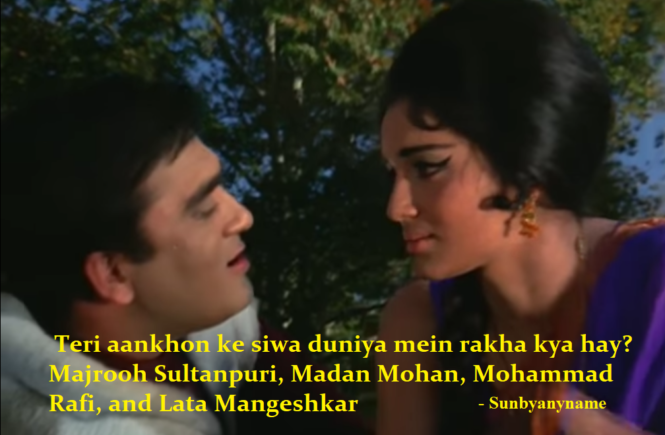Raaga Based Song of the Day: Teri aankhon ke siwa duniya mein rakha kya hai….
Raag Jhinjhoti, Tal Dadra
The legendary poet Faiz Ahmed Faiz wrote a nazm (poem) with the opening words: Mujh se pehli si mohabbat mere mehboob na maang. Malika-e-Tarannum (Queen of Melody) Noorjehan composed the nazm into an immortal ghazal in a gathering that was celebrating his release from prison (he was imprisoned for supporting Communist ideology). It became so popular because of her composition that she started being credited for having penned it in almost the same manner as Begum Akhtar owns Ai mohabbat tere anjaam pe rona aaya and not the poet Shakeel Badayuni.
The mukhada of that ghazal ended in the title of this song:
Mujh se pehli si muhabbat mere mehboob na maang
Maine samjhaa tha ke tu hai to darakhshaan hai hayaat
Tera gham hai to gham-e-dehar ka jhagdaa kyaa hai
Teri surat se hai aalam mein bahaaron ko sabaat
Teri aankhon ke siwaa duniyaa mein rakhkhaa kya hai
Raj Khosla, the director of the 1969 movie Chirag called the lyricist Majrooh Sultanpuri and asked him to use this line as the title of the song. Due permission was taken to do so. This is how this great song was born.
This song was first sung by Mohammad Rafi for Sunil Dutt in the movie. He addressed it to Asha Parekh. Later, Asha Parekh lip-synced it to Sunil Dutt in the voice of Lata Mangeshkar. This is the second song in succession in which I am giving you both the versions.
Today is the second time that I give you a song in this raaga. The first time I gave you a song in this raag was on the very first day: Tum mujhe youn bhula na paoge (Please see: ‘Raaga Based Song Of The Day #1‘).
I couldn’t have given you the best song ever composed in this raaga: Mere mehboob tujhe meri mohabbat ki kasam and hence I gave you what I thought was the second best. Coincidentally, that song, penned by Hasrat Jaipuri and composed by Shankar Jaikishan had two versions: first sung by Mohammad Rafi for Shammi Kapoor and then sung by Lata Mangeshkar for Asha Parikh. Ninety-five songs later we have come back to where we started from.
We have completed ninety-five days of Raaga Based Songs of the Day. Our first post in the series was titled ‘Raaga Based Song Of The Day #1’ and the song was a Mohammad Rafi and Lata Mangeshkar song from the 1970 Shakti Samanta movie Pagla Kahin Ka: Tum mujhe youn bhula na paoge. It is in Raag Jhinjhoti, Tal Kaherava.
Our ninety-fifth post or the last post here was titled ‘Raaga Based Song Of The Day #95‘ and the song was a Lata Mangeshkar song from the 1965 Kalidas movie Bheegi Raat starring Meena Kumari, Pradeep Kumar and Ashok Kumar: Dil jo na keh saka. It is in Raag Maru Bihag, Tal Kaherava.
This blog has a number of posts on Raaga based songs in Hindi movies titled similarly; for example: ‘The Best Raaga Based Songs in Hindi Movies – Raaga Darbari Kanada – Part I‘.
In the last ninety-five days of sharing Raaga based songs of the day, I have given you songs based on Raag Jhinjhoti, Gara, Bhimpalasi, Madhuvanti, Shivaranjani, Bihag, Pahadi, Sarang, Pilu, Bhairavi, Khammaj, Charukesi, Kalyan or Yaman, Desh, Malgunji, Kirwani, Kedar, Bageshri, Megh Malhar, Bhupali, Ahir Bhairav, Malkaush, Mand, Adana, Kafi, Rageshri, Jaunpuri, Tilang, Janasammohini, Chayanat, Shuddha Kalyan, Gaur Sarang, Jogiya, Asavari, Maru Bihag, Durga, Lalit, Puria Dhanashri, Bhinna Sahdja, Sohani, Multani, Patdeep, Jaijaiwanti, Tilak Kamod, Hemant, Basant Mukhari, Gujri Todi, Kalavati, Hamir, Bhatiyar, Gawati, Shyam Kalyan, Gorakh Kalyan, Madhamat Sarang, Manj Khammaj, Darbari Kanada, Vibhas, Shankara, Bahar, Nand and Mian Ki Malhar; making it a total of 61 raagas. The raagas that have been repeated so far are Pahadi, the raaga of my home place in the Himalayas, Maru Bihag, Raag Kirwani, Jhinjhoti, Bhairavi, Gara, Basant Mukhari, Malkauns, Bhairavi, Mand, Sohani, Madhuvanti, Shivaranjani and Adana. Today, I am repeating Raag Jhinjhoti for the second time.
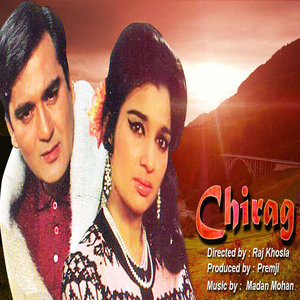
Today’s song is from the 1969 Raj Khosla movie Chirag starring Sunil Dutt and Asha Parekh. Lets understand the story-line to see where the two versions of the song fit in the movie:
Ajay Singh (Sunil Dutt) meets Asha Chibber (Asha Parekh) and is led to believe that she belongs to a wealthy family. After a few misunderstandings, he does find out that she is a simple girl living a poor lifestyle. Both do fall in love, and Ajay goes to meet with Asha’s brother, Dr. O.P. Chibber (Om Prakash), and his wife, Shanti (Sulochana Latkar). They are pleased to meet him, and Ajay’s mother, Gayetridevi (Lalita Pawar) visits them and approves of Asha. Ajay and Asha get married and settle down. After marriage Asha is expected to conceive, but she is unable to do so. After a certain incident she also loses her eyesight and becomes dependent on Ajay. Frustrated Gayetridevi decides to ask Asha to leave the house, and arranges a second marriage for Ajay.
The first time the song is sung is the happy occasion when they are in love and he finds in her eyes the world that is waiting for him after marriage. She sings the last stanza of the song indicating that for her too his eyes were the whole world.
The second time this song is sung is when she loses her eyesight. She begins with the stanza that she had sung earlier with him and now every word has a new meaning. She concludes with the second stanza saying that as long as his eyes were hers too, she would live by that support.
Clearly, the movie’s story revolves around this song. And that’s why Raj Khosla wanted to get it right by borrowing a line from Faiz’s famous nazm.
The lyricist of the song was, once again, Majrooh Sultanpuri and the composer was Madan Mohan. On my Facebook page Lyrical I have, in the last few months, put up over a hundred of my favourite songs penned by Majrooh Sultanpuri.
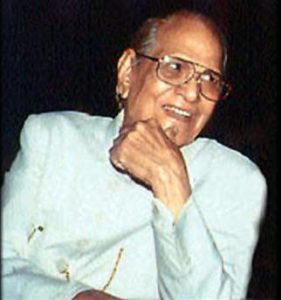 Majrooh Sultanpuri was born on 01 Oct 1919 as Asrar ul Hassan Khan in a Tarin Pashtun family, in Sultanpur, Uttar Pradesh. His father was an officer in the police department, but, preferred to send his son for traditional madrasa (Urdu school) rather than provide him with English schooling.
Majrooh Sultanpuri was born on 01 Oct 1919 as Asrar ul Hassan Khan in a Tarin Pashtun family, in Sultanpur, Uttar Pradesh. His father was an officer in the police department, but, preferred to send his son for traditional madrasa (Urdu school) rather than provide him with English schooling.
He tried his hand at being a quack until he was noticed in a mushaira in Sultanpur.
He was a disciple of the great Urdu poet Jigar Moradabadi. When he visited Bombay in 1945 to participate in a mushaira, the director Abdul Rashid Kardar noticed him and invited him to write for the movies. Majrooh turned it down as he looked down upon movies. He was persuaded through his mentor Jigar Moradabadi and then there was no turning back.
Many traditionalists of the Urdu literature, however, felt that Majrooh sold his soul to the Hindi films and that he could have emerged a great poet in the likeness of Ghalib and Jigar.
The takhalus Majrooh means “injured” or “wounded”.
Majrooh was awarded, in 1993, the highest award – Dadasaheb Phalke award – for his lifetime contribution towards lyrics and poetry. He was the first lyricist ever to be given that award. For the film Dosti, that made Laxmikant Pyarelal famous, he was awarded the Filmfare Best Lyricist Award for the song: Chahunga main tujhe saanjh savere.
For someone who didn’t want to join Hindi movies, Majrooh emerged as a natural lyricist, very popular, very romantic and one who kept pace with the changing times.
Madan Mohan was born on 25 June 1924, at Erbil, Iraqi Kurdistan, where his father Rai Bahadur Chunilal was working as an Accountant General with the Kurdistan Peshmerga forces. In the later part of his life Madan Mohan, frustrated at not finding enough assignments, took to heavy drinking and finally he died of liver cirrhosis on 14 July 1975, in Mumbai.
However, during the peak of his career, some of the most memorable songs of Mohammad Rafi (for example for Dev Anand starrer Sharabi; viz, Sawan ke mahine mein, Mujhe le chalo phir aaj us gali, and Kabhi na kabhi kahin na kahin koi na koi to aayega) and Lata Mangeshkar were composed by him. He was the composer of choice for Raj Khosla in that for his triology on Sadhana, Raj Khosla took Madan Mohan for two of the three movies: Woh Kaun Thi and Mera Saya. Some of his best songs are to be found in Haqeeqat, Aap Ki Parchhayiyan, Anpadh, Jahan Ara and Dekh Kabira Roya.
He earned the reputation of being the best composer of ghazals in the movies and these became very memorable; eg, for the movie Adaalat: Unako yeh shikayat hai ke ham kuchh nahin kehte, and Youn hasraton ke daag.
As far as Lata Mangeshkar is concerned, some of her most memorable songs have been composed by Madan Mohan either on the lyrics of Rajinder Krishan or Raja Mehdi Ali Khan. These include Lag jaa gale se phir, and Aapki nazaron ne samajha.
Madan Mohan and Majrooh Sultanpuri worked together in seven movies: Night Club (1958), Ek Shola (1958), Aakhri Dao (1958), Jagir (1959), Akeli Mat Jaiyo (1963), Chirag (1969) and Dastak (1970).
These films had some very beautiful songs. Some of these are: Nigaahon ka ishara hai bahon ka sahaara hai (Night Club, 1958); Kahin chal na de raat ka kya thikana (Ek Shola, 1958); Tujhe kya sunayun main dilruba, and Hamsafar saath apna chhod chale (Aakhri Dao, 1958); Maane na haay baalam pardesiya (Jagir, 1959); Ye to kaho kaun ho tum, Thodi der ke liye mere ho jayo, and Woh jo milate the kabhi (Akeli Mat Jaiyo, 1963); Teri aankhon ke siwa and Chirag dil ka jalao (Chirag, 1969); Baiyan na dharo, Ham hain mata-e-koocha-o bazaar ki tarah, Mai ri main kaise kahun, and Tumse kahoon ek baat (Dastak, 1970).
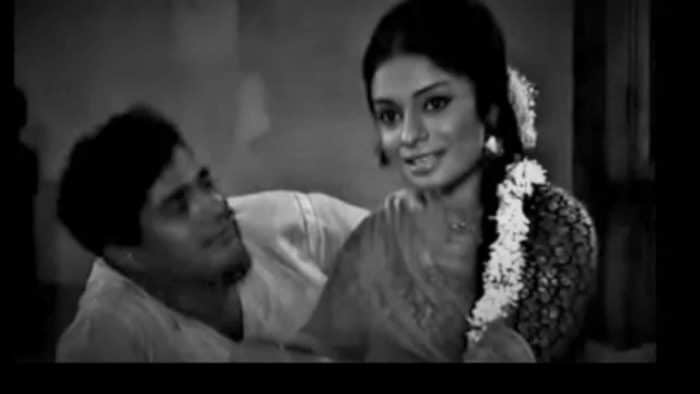
Madan Mohan also made many memorable songs based on Raagas. One of his most memorable numbers is in Raag Pahadi, Tal Dadra, which was penned by Raja Mehdi Ali Khan: Lag jaa gale ke phir.
This song, as I told you, is in Raag Jhinjhoti, Tal Dadra.
Raag Jhinjhoti, as I told you on the first day itself (Please go through ‘Raaga Based Song Of The Day #1‘) is a raag named after an apsara. It belongs to Khammaj or Khamaj thaat. Its Jati is Shadhav-Sampoorna (Vakra) (Nishad is Varjya in Aaroh, Nishad is Komal in Avroh. Rest all Shuddha Swaras). It is normally to be sung in the second prahar of the night (9 PM to midnight).
Hindi songs composed in this raag have an element of self-pity about them; eg, Tum mujhe youn bhula na paoge, Badli badli duniya hai meri, Mose chhal kiye jaaye, Chhup gaya koi re door se pukaar ke, Ghungroo ki tarah bajta hi raha hoon main, Jaayun kahan bata ai dil, and Koi hamdam na raha koi sahara na raha.
I have, at various places earlier, told you about the Dadra Tal and hence don’t feel the need to repeat it here (For example, the latest being in ‘Raaga Based Song Of The Day #93‘).
Before we actually take up the song, first, lets take up the value added learning of today. From the last fourteen times we started learning about some of the leading personalities in Indian Classical Music or Shastriya Sangeet. The first one that we took up was Ustaad Asad Ali Khan, the finest Rudra Veena player in the country. Then we took up Pandit Hari Parsad Chaurasia, the greatest Bansuri player in the country. Then we talked about Ali Akbar Khan, the greatest Sarod player in the country. Then we took up Pandit Ravi Shankar, the greatest Sitar player in the world. Then we took up the greatest classical singer in the country (of Carnatic tradition): MS Subbulakshmi. Then, we took up the greatest classical singer in the country (of Hindustani tradition): Pandit Bhimsen Joshi. Then, we learnt about the Shehnai maestro Ustad Bismillah Khan. Then, we learnt about Annapurna Devi, a great Surbahar (bass sitar) player of Hindustani Classical Music. Thereafter, we took up Pandit Shiv Kumar Sharma, the grestest Santoor player in the country. Then we learnt a little more about Ustaad Alla Rakha Qureshi or simply Alla Rakha, the Tabla Maestro and father of Ustaad Zakir Hussain. Then we learnt about the master and one of the pioneers of fusion: Anand Shankar. Then we learnt about a Veena player who was also a great filmmaker: Sundaram Balachander. Then we learnt about Sarod Player Ustad Amjad Ali Khan. And then we learnt about Ustaad Zakir Hussain, the Tabla maestro. Finally, we learnt about Sitar Player and Composer Anoushka Shankar.
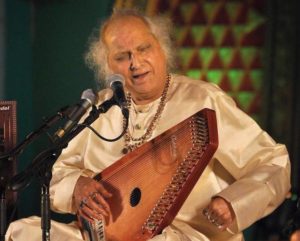
Tonight, we shall take up the great living vocalist: Pandit Jasraj of the Mewati gharana. He was born on 28 Jan 1930 in Village Pili Mandori in Hisar (now Fatehabad) district of Haryana. His father Motilal was a classical singer. He died when Jasraj was only 4 years old. Jasraj’s elder brother, Pratap Narain, was also an accomplished musician and was the father of music composer duo Jatin-Lalit, of singer-actress Sulakshana Pandit and of actress Vijeta Pandit.
Jasraj was initiated into vocal music by his father, but initially trained as an accompanist, playing the tabla at vocal performances by his brother, the singer Maniram. He credits the vocalist, Begum Akhtar, as inspiring him to take up classical music. Jasraj began training as a vocalist at the age of 15, and performed his first stage concert as a vocalist at the age of 22. Before becoming a stage performer, Jasraj worked as a performing artist on radio for several years.
Pandit Jasraj is a recipient of Padma Bhushan and Padma Vibushan (the third and second highest civilain honours in India). Jasraj has tutored several students who have gone on to perform as classical musicians including Sanjeev Abhyankar, Kala Ramnath,Tripti Mukherjee, Suman Ghosh, Kavita Krishnamurthy, Anuradha Paudwal, Sadhana Sargam, Shankar Mahadevan, and Ramesh Narayan.
Pandit Jasraj is married to Madhura Shantaram, the daughter of film director V Shantaram.
Returning to the song now. For a great song by both Majrooh and Madan Mohan, neither the direction nor cinematography is actually great. Even the acting by the lead actors is average. However, that doesn’t take away from the song superb lyrics, outstanding composition and remarkable singing by both Mohammad Rafi and Lata Mangehskar.
Ladies and gentlemen, please enjoy in Raag Jhinjhoti Tal Dadra, first Mohammad Rafi and Lata (one stanza) and later in the movie Lata sing a composition of Madan Mohan on the lyrics of Majrooh Sultanpuri in the 1969 Raj Khosla movie Chirag starring Sunil Dutt and Asha Parekh: Teri aankhon ke siwa duniya mein rakha kya hai…..
Mohammad Rafi and Lata First:
तेरी आँखों के सिवा दुनिया में रक्खा क्या है
ये उठें सुबह चले, ये झुकें शाम ढले
मेरा जीना मेरा मरना इन्हीं पलकों के तले
तेरी आँखों के सिवा …
Rafi
पलकों की गलियों में चेहरे बहारों के हँसते हुए
हैं मेरे ख़ाबों के क्या-क्या नगर इनमें बसते हुए
ये उठें सुबह चले …
इनमें मेरे आनेवाले ज़माने की तस्वीर है
चाहत के काजल से लिखी हुई मेरी तक़दीर है
ये उठें सुबह चले …
Lata
ये हों कहीं इनका साया मेरे दिल से जाता नहीं
इनके सिवा अब तो कुछ भी नज़र मुझको आता नहीं
ये उठें सुबह चले …
Lata Now: Asha Parekh is blinded and the words have a different meaning. She is looking forward to seeing the world through his eyes. Majrooh has done outstandingly well with the lyrics especially इनके सिवा अब तो कुछ भी नज़र मुझको आता नहीं:
तेरी आँखों के सिवा दुनिया में रक्खा क्या है
ये उठें सुबह चले, ये झुकें शाम ढले
मेरा जीना मेरा मरना इन्हीं पलकों के तले
तेरी आँखों के सिवा …
ये हों कहीं इनका साया मेरे दिल से जाता नहीं
इनके सिवा अब तो कुछ भी नज़र मुझको आता नहीं
ये उठें सुबह चले …
ठोकर जहाँ मैने खाई इन्होंने पुकारा मुझे
ये हमसफ़र हैं तो काफ़ी है इनका सहारा मुझे
ये उठें सुबह चले …
We have intended to learn about Raaga based music whilst we entertain ourselves with Raaga based songs. So, lets, once again, take stock of our collective learning so far:
- On the first day we learnt about the Raaga system devised by Pandit Vishnu Narayan Bhatkhande, which is the prevalent system in Hindustani Classical Music and based on ten Thaats.
- On the second day we learnt about Tal or Taal.
- On the third day we learnt about characteristics of Raagas that included Swar, Jati, Thaat, Arohana and Avarohana, Vadi, Samvadi and Pakad.
- On the fourth day, we learnt about Sargam.
- On the fifth day, we learnt about notations used in Indian classical music or simply Swar Lipi.
- On the sixth day, we learnt about the Ras (sentiments) that Raagas evoke.
- On the seventh day, we learnt about various types of Swar: Shuddha, Achal, Vikrut, Komal and Teevra.
- On the eighth day, we learnt the parts of a composition in Indian Classical Music.
- On the ninth day, we learnt the names of some of the popular instruments used in Indian Classical Music.
- On the tenth day, we learnt about the sources of names of Raagas.
- On the eleventh day, we learnt about why Bhairavi is the first raag to be taught to beginners and also why it is the last in a performance.
- On the twelfth day, we learnt about Khammaj Thaat.
- On the thirteenth day, we learnt about Tal Punjabi Theka or Sitarkhani.
- On the fourteenth day, we learnt about Alap.
- On the fifteenth day, we learnt about List of Raagas (Raagmala) in my favourite book: Sri Guru Granth Sahib.
- On the sixteenth day, we learnt about tips for raaga identification.
- On the seventeenth day, we learnt the basics of Gharana system.
- On the eighteenth day, we learnt about Filmi Sangeet.
- On the nineteenth day, we learnt about the commonest Tal in Raagas: Tintal.
- On the twentieth day, we learnt about the Kafi Thaat.
- On the twenty-first day, we learnt a little more in detail about the classification of Raagas.
- On the twenty-second day, we learnt the essential differences between Bhairavi and Bhairav.
- On the twenty-third day, we learnt a little more in detail about the Jati or Jaati of a raaga.
- On the twenty-fourth day, we learnt details of Thaat Bilawal, the most basic thaat in the Bhatkhande’s system of raagas.
- On the twenty-fifth day, we learnt about Tintal.
- On the twenty-sixth day, we learnt in detail about the Raaga – Samay linkage.
- On the twenty-seventh day, we learnt about Lehar.
- On the twenty-eighth day, we learnt about the history of the Hindustani Music.
- On the twenty-ninth day, we learnt about Dhrupad.
- On the thirtieth day, we learnt about Rupaktal that I was introduced to, a few months back, by my friend Anand Desai.
- On the thirty-first day, we learnt about Khayal.
- On the thirty-second day, we learnt about Thumri.
- On the thirty-third day, we learnt about Tappa.
- On the thirty-fourth day, we learnt about Tarana.
- On the thirty-fifth day, we learnt about Tal Dipchandi (Moghali).
- On the thirty-sixth day, we learnt about Tabla.
- On the thirty-seventh day, we learnt about Kirtan.
- On the thirty-eighth day, we learnt about Pakhawaj.
- On the thirty-ninth day, we learnt about Hori.
- On the fortieth day, we learnt about Dadra.
- On the forty-first day, we learnt about Kajri.
- On the forty-second day, we learnt about Chaiti.
- On the forty-third day, we learnt about Sarangi.
- On the forty-fourth day, we learnt about Shehnai.
- On the forty-fifth day, we learnt about Sarod.
- On the forty-sixth day, we learnt about Bansuri.
- On the forty-seventh day, we learnt about Ektal and Tanpura.
- On the forty-eighth day, we learnt about Veena.
- On the forty-ninth day, we repeated our learning of Veena with a small excitement added.
- On the fiftieth day, we learnt about Dilruba/Esraj.
- On the fifty-first day, we learnt about Jaltarang.
- On the fifty-second day we learnt about Qawwali.
- On the fifty-third day, we learnt about Sitar.
- On the fifty-fourth day, we learnt about Surbahar.
- On the fifty-fifth day, we learnt about Harmonium.
- On the fifty-sixth day, we learnt about Santoor.
- On the fifty-seventh day, we learnt about Swarmandal.
- On the fifty-eighth day, we learnt about the Shruti Box.
- On the fifty-ninth day, we learnt about Alankar.
- On the sixtieth day, we learnt about singing in Aakaar.
- On the sixty-first day, we learnt about the Classification of Indian Musical Instruments.
- On the sixty-second day, we learnt a little about Carnatic Music.
- On the sixty-third day, we learnt about Natya Shastra.
- On the sixty-fourth day, we learnt about evolution of musical instruments in India down the ages.
- On the sixty-fifth day, we learnt about Riyaaz.
- On the sixty-sixth day, we looked at a list of Raagas in Hindustani Classical Music.
- On the sixty-seventh day, we learnt about the health benefits of raagas.
- On the sixty-eighth day, we learnt a little more comprehensively about the moods and emotions that raagas evoke.
- On the sixty-ninth day, we learnt about a mobile application to help identify raagas.
- On the seventieth day, we learnt about Melakarta Raagas.
- On the seventy-first day, we learnt about Sangita Makarand.
- On the seventy-second day, we learnt about TaalMala an Android application for personalized accompaniment of musical instruments during Riyaaz or even during Concert.
- On the seventy-third day, we learnt about Indian Classical Ragas, an Android application for mobile phones.
- On the seventy-fourth day, we learnt about Saregama Classical, another application for Classical Raagas.
- On the seventy-fifth day, we learnt about a free online service available to learn Indian Classical Music.
- On the seventy-sixth day, we learnt about List of Hindustani Classical Musical Festivals in India and Abroad.
- On the seventy-seventh day, we learnt about List of Carnatic Musical Festivals in India and Abroad.
- On the seventy-eighth day, we learnt about Jhaptal.
- On the seventy-ninth day, we learnt about Ektal.
- On the eightieth day, we learnt about Tivra Tal.
- On the eighty-first day, we learnt about the greatest Rudra Veena player ever: Ustaad Asad Ali Khan.
- On the eighty-second day, we learnt about the greatest Bansuri player alive: Pandit Hariprasad Chaurasia.
- On the eighty-third day, we learnt about the best Sarod player in the country: Ustaad Ali Akbar Khan.
- On the eighty-fourth day, we learnt about the greatest Sitar player in the world: Pandit Ravi Shankar.
- On the eighty-fifth day, we learnt about the greatest Indian vocalist of Carnatic tradition: MS Subbulakshmi.
- On the eighty-sixth day, we not just learnt about the greatest vocalist of Hindustani tradition: Pandit Bhimsen Joshi but also learnt about Tal Hinch.
- On the eighty-seventh day, we learnt about the Shehnai maestro Ustaad Bismillah Khan.
- On the eighty-eighth day, we learnt about Annapurna Devi, the greatest Surbahar player in India.
- On the eighty-ninth day, we learnt about Pandit Shiv Kumar Sharma, the greatest Santoor Player in the country.
- On the ninetieth day, we learnt about Ustaad Alla Rakha, the Tabla maestro.
- On the ninety-first day, we learnt about Anand Shankar, the great fusion musician from Bengal.
- On the ninety-second day, we learnt about Sundaram Balachander, the great Veena player and film-maker.
- On the ninety-third day, we learnt about Ustaad Amjad Ali Khan, the great Sarod player.
- On the ninety-fourth day, we learnt about the Tabla maestro: Ustaad Zakir Hussain.
- On the ninety-fifth day, we learnt about the Sitar player and Composer: Anoushka Shankar.
- And today, on the ninety-sixth day, we learnt about the Vocalist Pandit Jasraj.
There is much more still to be learnt and enjoyed.
Please stay tuned!
